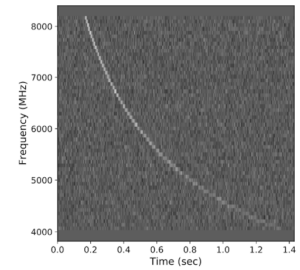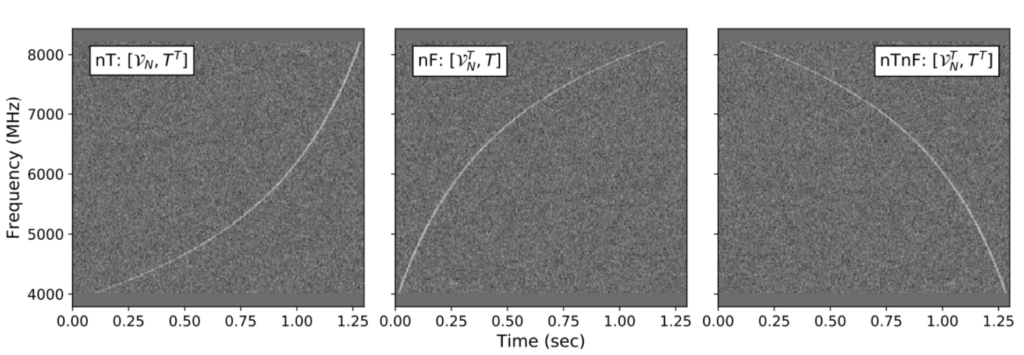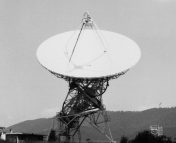Title: Searching for broadband pulsed beacons from 1883 stars using neural networks
Authors: Vishal Gajjar, Dominic LeDuc, Jiani Chen, Andrew P. V. Siemion, Sofia Z. Sheikh, Bryan Brzycki, Steve Croft, Daniel Czech, David DeBoer, Julia DeMarines, Jamie Drew, Howard Isaacson, Brian C. Lacki, Matt Lebofsky, David H. E. MacMahon, Cherry Ng, Imke de Pater, Karen I. Perez, Danny C. Price, Akshay Suresh, Claire Webb, and S. Pete Worden
First Author’s Institution: Breakthrough Listen, University of California Berkeley
Status: Submitted to the Astrophysical Journal [open access]
The search for extraterrestrial intelligence (SETI) is perhaps humankind’s most ambitious and forward-thinking endeavor. We’ve been asking ourselves the fundamental question of “Are we alone?” since the dawn of written history, but technological advancements in the last 100 years have allowed us to take our first steps into finding an answer. Today’s paper describes a reimagination of one of the most common search techniques to look for signatures of extraterrestrials (ETs), and while we haven’t found any alien signals just yet, our search capabilities only continue to get better!
The easiest way to find ETs would be to look for their technosignatures– the light waves emitting from the technology they use (check out this Astrobite for more on technosignatures). In particular, if an alien civilization was sending out a signal with the express purpose of being found by other intelligent life, they would want to send it out using a signal that wouldn’t be deflected or absorbed by the space between us, that would travel as fast as possible, and that would require the least amount of energy to produce. For these and other reasons, most SETI searches have involved searching for artificial radio signals coming from the vicinity of nearby stars.
But what specific kinds of signals should we search for? Will they be transmitted over a very narrow frequency range, or be ‘broadband’ signals with a large bandwidth? Will the signal be continuously transmitted, or will it pulse on and off at specific intervals to clearly demonstrate it’s made by intelligent life? There is no one satisfactory answer to these questions, and most previous searches have looked for narrowband signals that are always being emitted, since we would need less time to detect a signal of that type than other types of signals.
However, the authors of this paper were able to prove that for a civilization generating these signals, it would cost less energy to produce broadband pulsed signals, as long as those signals were being sent out for longer than a few hundred seconds. They made the reasonable assumption that ETs will try for longer than a few minutes to get our attention, and went about searching for broadband pulsed signals in radio data from the Green Bank Telescope.
A Very Small Needle in a Turbulent Haystack
The Breakthrough Listen collaboration, which this paper is a part of, chose 1,883 stars (explained in this paper) as targets for their observations. They chose every star within 5 parsecs of Earth (a little over 16 light years), so that the distance between us would not attenuate the signals too much; they also chose every star from 5-50 parsecs (within 163 light years) which fall on the main sequence as well as the early part of the giant branch. Stars on these earlier segments of the stellar evolutionary track are less volatile and, if they have planets orbiting them, create environments which are the most likely to aid life to grow. They took 233 total hours of observations, breaking them up into 5-minute segments, since that is approximately the observational length where a 0.3-millisecond long broadband pulse would take less power to send than a continuous narrowband signal.
Luckily, we have lots of experience in searching for repeating broadband radio pulses- in the form of radio pulsars and fast radio bursts! Pulsars are very useful physical tools for a wide range of astronomical applications (for more, see the Astrobites here, here, here, here, here, here, and here), but today, we can use our experience in analyzing transient radio signals to predict how a broadband signal sent by ETs would be affected by the interstellar medium between us. Radio waves are scattered and dispersed by the interstellar medium, and it is dispersion which the authors focus on. Broadband radio signals undergo a dispersion delay, where the lower-frequency part of a pulse will be delayed relative to the higher-frequency part due to the ionized medium it travels through.

Figure 1 shows a ‘waterfall’ plot, or the intensity as a function of frequency and time, for a single broadband pulse which has undergone dispersion. The dispersion measure (DM) of a signal, related to the time delay between two reference frequencies, can help us measure the amount of ionized material a signal has traveled through, and along with detailed maps of the Milky Way, we can use DM to estimate the distance between us and the originator of the signal!
Most importantly, the dispersion delay time between two frequencies always scales as the inverse of the frequency difference, squared. The authors of today’s paper suggest that if an alien civilization were to send us a signal, they would want to artificially arrange it in some way so that we would not see a normal dispersion trend; rather, we would see some other pattern that does not occur in nature, proving that it comes from other sentient life. These other types of artificial dispersion (aDM) are shown in Figure 2. The authors searched for dispersed pulses from their original dataset, and they also created artificial datasets by flipping the frequency and time axes, both independently and simultaneously. By doing this, each type of artificially dispersed pulse shown in Figure 2 would look to the single-pulse-search software as a normally dispersed pulse, allowing them to run the identical search code on all four datasets. Searching all of these datasets resulted in a staggering 133,393 candidates!

How to Analyze 133,000 Candidates This Century
Of course, having a human sit down and examine that many candidates would be beyond unreasonable– thankfully, machine learning and GPU processing allow us to quickly filter out many bad options. The authors filtered out candidates which looked too much like human-made radio frequency interference (RFI), or didn’t show enough of a difference between their on-pulse and off-pulse energy distributions. Many other filters were used to weed out unpromising candidates, leading to a shortlist of only 2,948 candidates.
The best candidates in each class of aDM were examined more closely, but similar-looking signals were found in other 5-minute long pointings in completely unrelated areas of the sky. It’s not easy for us to prove definitively that these signals actually come from the region of the stars we’re pointing at, rather than RFI; so it’s much more reasonable to conclude that these ‘signals’ are bright RFI signals which have made their way into the telescope, rather than two extremely distant alien civilizations sending us the exact same signal.
The authors used these non-detections to place limits on the maximum signal strength any civilization in those areas could be sending- with some as weak as a few hundred times stronger than our strongest airplane radar. That doesn’t sound like much of a limit, but that’s a signal we’d be detecting from a whole other star system– and each new search is another step towards better technology and better search methods to make a possible discovery!
Astrobite edited by Lili Alderson
Featured image credit: Jingchuan Yu, Beijing Planetarium




